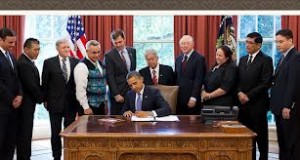
(TheNicheReport) -- President Obama signed the Helping Expedite and Advance Responsible Tribal Homeownership (HEARTH) Act 2012 into law July 30, 2012. This law allows tribes to lease restricted lands without the approval of the Secretary of the Interior. Perhaps a little background will help explain.
Tribes and tribal land are considered sovereign from the United States. However, the U.S. still holds much of tribal land in trust. Because it’s held in trust, mortgage companies can’t place a lien against any property on tribal land, and thus they don’t want to issue a loan. To solve this problem, the U.S. government issued Section 184, which gave the Secretary of the Interior power to lease the land and made it possible for a lien to be placed on that lease.
The problem, however, is that approving a lease takes a lot of time. The Indian Land Tenure Foundation reports that it could take up to a year, while it has been reported to take as long as two years.
Enter: HEARTH Act 2012. This act enables tribes to approve leases themselves (provided the Secretary of the Interior has approved the tribe’s regulations, and the tribe has a committee in place to determine the environmental impact the leasing will have). Ideally, this will “expedite” the lease-approving process.
Effect on the Mortgage Industry
The HEARTH Act 2012 will positively affect the mortgage industry because it allows more of a good thing. If Section 184 loans are like water, HEARTH 2012 allows more water to enter the industry without saturating it (as I’ll show below).
So, then, why is Section 184 good for the mortgage industry?
Osage News reported that in 2011 about 10 percent of Native Americans living in the town of Naytahwash (on the White Earth reservation) owned their own home. The rest were renters. This ratio gives a general snapshot of how Native Americans live. Section 184 opens up these homes to both the buyer and the bank. But this, in itself, doesn’t make it good for the mortgage industry. As we’ve seen, simply selling someone a loan isn’t a good thing. It’s the nature of Section 184 loans that make it good.
First, all Section 184 loans are guaranteed by HUD. This encourages banks to make loans to Native Americans. In fact, HUD reports that while the rest of the loan market took a downturn, the Section 184 market did not.
Second, a lender must be approved to make Section 184 loans, which keeps lenders from taking advantage of Native Americans and risking the market.
Third, interest rates are based on the market and not on the credit score of the applicant. This seems like a risk, until you take two things into consideration. First, Native Americans don’t do finances like the rest of America. As reported in the Osage News article noted early, Native Americans are much more apt to do business by a handshake. Some don’t even own bank accounts, so Native Americans don’t necessarily have bad credit; just no credit.
The second consideration is HEARTH 2012 itself. Since HEARTH will allow more people to receive Section 184 loans quicker, lenders can increase their portfolio and their chance of making money.
Won’t this saturate the market? No, but only because HEARTH 2012 doesn’t allow a flood. Back to the water analogy: HEARTH 2012 opens the water bottle cap a little wider, but doesn’t take the cap all the way off. If the federal government opened it up for lenders to create leases themselves (without going through the U.S. or tribal government) then you could possibly see market saturation. But HEARTH 2012 still requires a process that will space out applicants and moderate the market.
In truth, only time will tell what impact HEARTH 2012 has on the mortgage market. Given the facts, though, it looks like HEARTH 2012 will allow everyone to win: More Native Americans will get to own a home while lenders will have more chances to make a profit.
Tim Richmond is a writer, amateur historian and blogger who writes about the economy, finance, sustainable living and home ownership. He currently writes for the Native American home loan specialists 1tribal.com.



